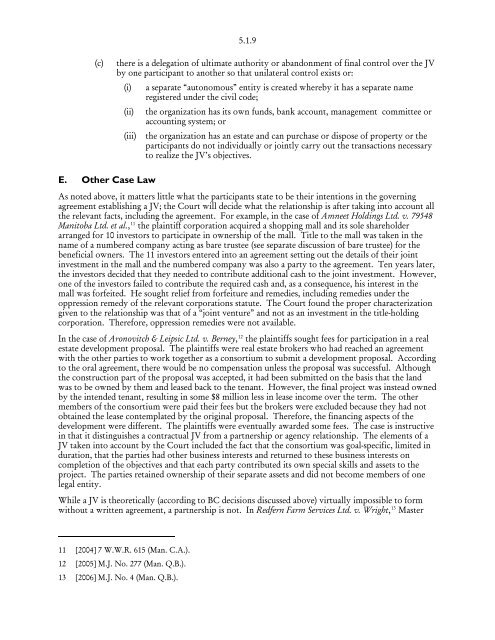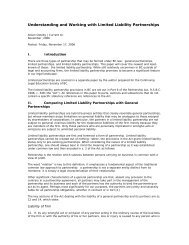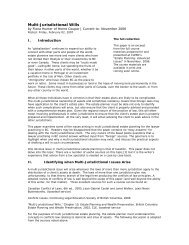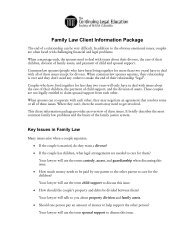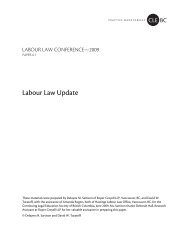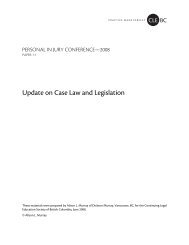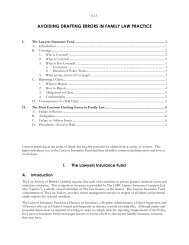Joint Ventures-The Limited Fiduciary Relationship Structure
Joint Ventures-The Limited Fiduciary Relationship Structure
Joint Ventures-The Limited Fiduciary Relationship Structure
You also want an ePaper? Increase the reach of your titles
YUMPU automatically turns print PDFs into web optimized ePapers that Google loves.
5.1.9<br />
(c)<br />
there is a delegation of ultimate authority or abandonment of final control over the JV<br />
by one participant to another so that unilateral control exists or:<br />
(i)<br />
(ii)<br />
(iii)<br />
a separate “autonomous” entity is created whereby it has a separate name<br />
registered under the civil code;<br />
the organization has its own funds, bank account, management committee or<br />
accounting system; or<br />
the organization has an estate and can purchase or dispose of property or the<br />
participants do not individually or jointly carry out the transactions necessary<br />
to realize the JV’s objectives.<br />
E. Other Case Law<br />
As noted above, it matters little what the participants state to be their intentions in the governing<br />
agreement establishing a JV; the Court will decide what the relationship is after taking into account all<br />
the relevant facts, including the agreement. For example, in the case of Amneet Holdings Ltd. v. 79548<br />
Manitoba Ltd. et al., 11 the plaintiff corporation acquired a shopping mall and its sole shareholder<br />
arranged for 10 investors to participate in ownership of the mall. Title to the mall was taken in the<br />
name of a numbered company acting as bare trustee (see separate discussion of bare trustee) for the<br />
beneficial owners. <strong>The</strong> 11 investors entered into an agreement setting out the details of their joint<br />
investment in the mall and the numbered company was also a party to the agreement. Ten years later,<br />
the investors decided that they needed to contribute additional cash to the joint investment. However,<br />
one of the investors failed to contribute the required cash and, as a consequence, his interest in the<br />
mall was forfeited. He sought relief from forfeiture and remedies, including remedies under the<br />
oppression remedy of the relevant corporations statute. <strong>The</strong> Court found the proper characterization<br />
given to the relationship was that of a “joint venture” and not as an investment in the title-holding<br />
corporation. <strong>The</strong>refore, oppression remedies were not available.<br />
In the case of Aronovitch & Leipsic Ltd. v. Berney, 12 the plaintiffs sought fees for participation in a real<br />
estate development proposal. <strong>The</strong> plaintiffs were real estate brokers who had reached an agreement<br />
with the other parties to work together as a consortium to submit a development proposal. According<br />
to the oral agreement, there would be no compensation unless the proposal was successful. Although<br />
the construction part of the proposal was accepted, it had been submitted on the basis that the land<br />
was to be owned by them and leased back to the tenant. However, the final project was instead owned<br />
by the intended tenant, resulting in some $8 million less in lease income over the term. <strong>The</strong> other<br />
members of the consortium were paid their fees but the brokers were excluded because they had not<br />
obtained the lease contemplated by the original proposal. <strong>The</strong>refore, the financing aspects of the<br />
development were different. <strong>The</strong> plaintiffs were eventually awarded some fees. <strong>The</strong> case is instructive<br />
in that it distinguishes a contractual JV from a partnership or agency relationship. <strong>The</strong> elements of a<br />
JV taken into account by the Court included the fact that the consortium was goal-specific, limited in<br />
duration, that the parties had other business interests and returned to these business interests on<br />
completion of the objectives and that each party contributed its own special skills and assets to the<br />
project. <strong>The</strong> parties retained ownership of their separate assets and did not become members of one<br />
legal entity.<br />
While a JV is theoretically (according to BC decisions discussed above) virtually impossible to form<br />
without a written agreement, a partnership is not. In Redfern Farm Services Ltd. v. Wright, 13 Master<br />
11 [2004] 7 W.W.R. 615 (Man. C.A.).<br />
12 [2005] M.J. No. 277 (Man. Q.B.).<br />
13 [2006] M.J. No. 4 (Man. Q.B.).


